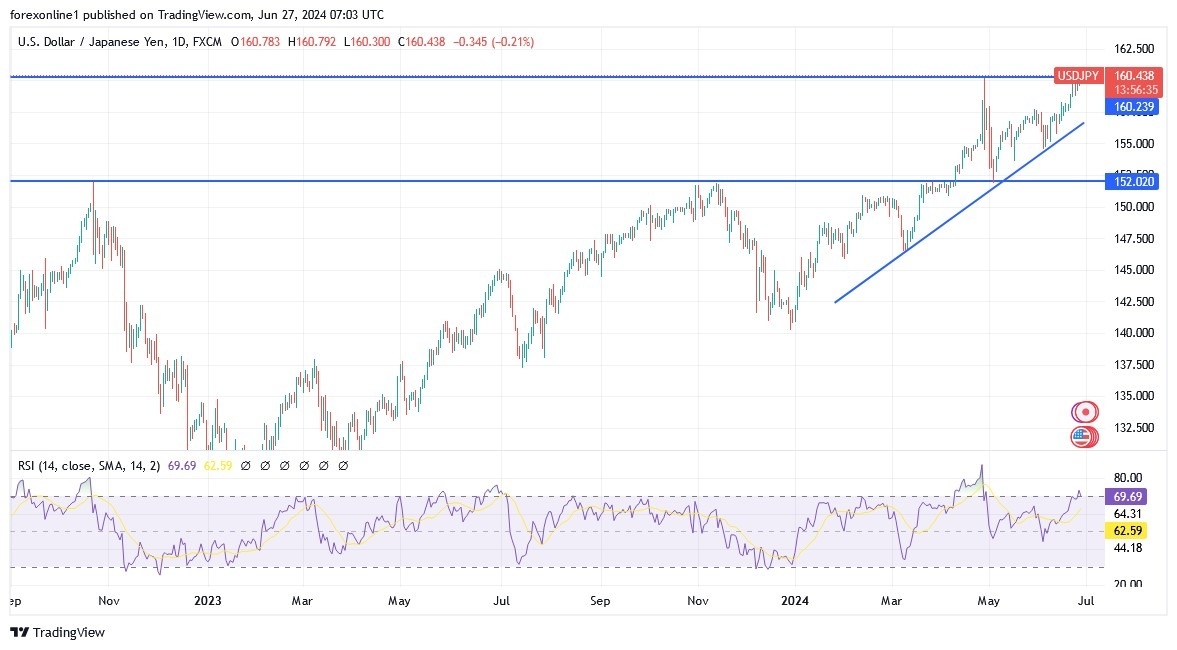- The Japanese yen suddenly fell to its weakest level since 1986, increasing speculation and authorities may soon have to support the currency again to stop the worst selling in the developed world.
- According to reliable trading platforms, the US dollar against the Japanese yen USD/JPY rose to the resistance level of 160.86, its lowest since 1986.
- With the move, the currency pair surpassed the point where officials intervened in the market in April, bringing losses this year to more than 12%.
- Against the euro, it fell to its lowest levels ever.
In general, a weaker currency increases the prices of imports, hurting Japanese consumers and causing increasing concern among businesses. Commenting on the performance, Masato Kanda, Vice Minister of Finance and Governor of the Japanese currency, said on Wednesday that officials are monitoring foreign exchange markets with a high degree of urgency and will take appropriate steps as needed. He described the latest move in the currency as “rapid” and “unilateral,” but declined to comment on whether it was excessive. The yen extended losses after his comments.
Meanwhile, the wide gap between interest rates in Japan — where borrowing costs remain close to zero — and the United States has continued to weigh on the yen despite attempts to contain the decline. The next big pain point could come from Friday’s reading of the Federal Reserve’s preferred measure of U.S. inflation, which is key to its monetary policy outlook.
What’s next for the yen?
“The comments from the finance ministry in recent days suggest growing concern,” said Erik Nelson, a strategist at Wells Fargo in London. He expects officials to hold out until the currency drops to 165 against the U.S. dollar before entering the market, a level that banks including Bank of America say is the new “line in the sand” for authorities.
There’s a lot at stake for Japan, which has spent a record 9.8 trillion yen ($61.1 billion) in its latest round of intervention. Citigroup estimates the country has between $200 billion and $300 billion in ammunition to fund any campaign, which could entail selling U.S. dollars and other currencies it holds in reserves or even government bonds around the world to buy yen.
For Dominik Kohnstamm, any intervention is more about “slowing the yen’s bottom” while the Bank of Japan normalizes monetary policy.
So far this week, officials in Tokyo have limited themselves to verbal warnings. Finance Minister Shunichi Suzuki said they were closely monitoring developments in the market and would take all possible measures as needed. Currency Governor Kanda warned on Monday that authorities were ready to intervene 24 hours a day, if necessary, while reiterating that they were not targeting a specific level.
Japan’s previous move to support its currency market has raised eyebrows abroad, with the U.S. Treasury Department last week adding the country to a “watch list” for foreign exchange market practices. While the U.S. stopped short of labeling Japan — or any other trading partner — a currency manipulator, officials in Washington wrote that “in large, freely traded exchange markets, intervention should be limited to very exceptional circumstances with appropriate prior consultation.”
Top Forex Brokers
The U.S. is adding Japan to its foreign exchange watch list amid global pressure on the strong dollar. However, U.S. data on Friday could ease some pressure on the yen. Moreover, economists expect core personal consumption expenditures inflation — a measure that excludes volatile food and energy categories — to slow, which could bolster the Federal Reserve’s case for lowering borrowing costs this year.
Also, volatility has remained relatively low in the market, making it difficult for authorities to enter the market so far, many analysts say. Furthermore, the implied volatility of the USD/JPY exchange rate over one month hovered below 9% for most of this month, down sharply from 12.4% in late April.
USD/JPY Technical Analysis and Expectations Today
With the recent move in the USD/JPY exchange rate, all technical indicators have moved towards strong overbought levels. Accordingly, the markets are awaiting the moment of Japanese intervention in the currency markets to stop the bleeding of the exchange rate losses, and that an event will bring strong selling operations for profit-taking in the currency pair. Currently, the closest resistance levels for the currency pair are 160.80, 161.20, and 162.00, respectively.
Ready to trade our daily forex forecast? Here are the best forex brokers in Japan to choose from.


